Review: Airfix 1/48 P-51D-5 Mustang
The 361st Fighter Group and “Lou IV”:
The 361st Fighter Group, comprising the 374th, 375th and 376th Fighter Squadrons, came into existence on February 10, 1943 at Richmond Army Air Base, Virginia. The unit was formed with trained personnel from the 327th Fighter Group, and new graduates of flight schools and technical schools. The Commanding Officer was Major Thomas J.J. Christian, Jr., great-grandson of the famous Civil War general “Stonewall” Jackson.
Following training through most of 1943 on the P-47 Thunderbolt, the 361st was ordered to join the 8th Air Force in England and moved to the United Kingdom in November 1943, arriving on November 29. After an overnight train journey, the unit arrived at RAF Bottisham, Cambridgeshire, where they were assigned to VIII Fighter Command, 8th Air Force.
After training in England, the 361st flew their first combat mission, a”Rodeo” to St. Omer, France, on January 23, 1944. The Group claimed its first victories on January 30, when pilots from the 374th Fighter Squadron shot down four Bf-109s near Rheine, Germany. The unit gained their combat spurs during “Big Week” in February. On March 6, while providing withdrawal support for the first Berlin mission, the group claimed five Fw-190s destroyed for no loss and followed this up on March 8 on the second Berlin mission with claims for 2more Bf-109s.
On March 11, Lt. Col. Christian and four other pilots from the group participated in training for strafing and dive-bombing missions, which would become a speciality of the 361st. Their first strafing mission was flown against the German airfield at Chartres on March 17.
On May 1,1944, the 361st received 17 new P-51B Mustangs and began re-equipment from the P-47. The first all-Mustang mission was flown on May 13, and on May 19 the 361st flew their first escort mission to Berlin. On May 27, Maj. George L. Merritt, Jr., commanding the 375th Fighter Squadron, became the group's first ace when he shot down a Fw-190 near Lille.
The 361st was in the thick of things with the invasion of Normandy in June, flying six strafing and dive-bombing missions on June 6 alone, during which 15 locomotives and an ammunition train were destroyed, as well a 23 trucks and armored vehicels and two enemy aircraft on the ground. The group continued to fly ground attack missions throughout June and July during the Battle of Normandy, demonstrating real proficiency in dive-bombing, and also demonstrating the vulnerability of the Mustang, with its liquid-cooled engine, to ground fire as 10 pilots were killed or posted Missing in Action during that time.
On June 29, the group scored 16 aircraft destroyed on a strafing mission to Oschersleben, Germany. On August 12, 1944, four dive-bombing and strafing missions were flown against rail transportation targets in France with the loss of Lts. John E. Engstrom and Merle C. Rainey of the 375th FS, Lt. Clarence E. Zieske of the 374th FS and the Group Commander, Col. Thomas J.J. Christian, Jr.
In September,1944, the group provided air cover for Operation Market Garden, the airborne assault on northern Holland that ended in the defeat of the British 6th Airborne Division and the likely extension of the war by 5-6 months as a result of the British failure. September also saw Lt. Urban Drew of the 375th FS open his score by shooting down an He-111 on September 18. In October, Drew would make a name for himself by shooting down two new Me-262s of Kommando Nowotny at Achmer as they were landing.
Even though the group scored well in aerial combat throughout the summer and fall of 1944, they were still better-known as a tactical unit for their dive-bombing and strafing missions. In December 23, 1944, the Group sent 60 P-51s and pilots, nine ground officers and 137 enlisted men to airdrome A-64 at St. Dizier, France, to support 9th AF operations in the Battle of the Bulge, commencing assignment to the tactical battles on the continent that would last until April 1945. During these four months, the group flew escort missions for the 8th Air Force over Germany, for medium bombers of the 9th Air Force over the battlefield, and for RAF Heavies on their daylight missions into western Germany, as well as flying dive-bombing and ground attack missions over Holland and Western Germany from Chievres, Belgium, a base they shared with the 352nd Fighter Group of the 8th Air Force. While flying escort missions, the group also became specialists at skipping bombs into railway tunnels to destroy hidden trains. In March, the group flew air cover over the Bridge at Remagen, where the first penetration was made by Allied ground forces of Germany proper. On March 24, the 361st flew six missions in support of the Allied airborne crossing of the Rhine.
On April 4, 1945, during a target escort mission to Parchim airfield, the 361st had their last aerial battle with the Luftwaffe. The B-24s were attacked three times by 30 Me262s, during which Lt. James T. Sloan of the 374th FS claimed one destroyed, while other pilots of the 374th and 375th squadrons claimed 12 Me262s damaged, for no loss.
On April 8,the 361st received orders to return to their English base at Little Walden, which was accomplished on April 9 at the conclusion of an uneventful escort mission to Lechfeld. On April 17, one section of the Group escorted 2nd Air Division bombers attacking rail targets in Czechoslovakia while a second section strafed Pilsen and Eger airfields, claiming six destroyed and seven damaged for the last claims of the war.
On May 8, 1945, the war in Europe was over. The 361st had flown 441 combat missions in 15 months of operations from air bases in England, France and Belgium, during which the Group claimed 226 enemy aircraft destroyed in the air and 105 on the ground, for the loss of 81 aircraft. On May 18, war-weary P-47s arrived at Little Walden and the 361st began retraining on the Thunderbolt for transfer to the Pacific, which never happened with the end of the Second World War on August 15.
Blue or Green Mustangs:
There are a very few controversies in modeling that can define friendships good or bad, and are likely to never ever be brought to a final, definitive end by the introduction of evidence, informed historical deduction, detailed chemical analysis of the photographic development process, or anything else.
One of these is: did the P-51s of the 361st Fighter Group in the summer of 1944 have green or blue camouflaged upper surfaces. I have seen good friends stop speaking to each other over this issue.
All this sturm und drang comes from a series of photographs taken of four aircraft of the 361st in July, 1944, which are well-known because they are among the few photos taken during World War II in color. One could almost wish they were in the then-standard black-and-white, since they would have generated less controversy. While the most controversy has swirled particularly around the P-51 flown by the group commander, Lt. Col. Thomas J.J. Christian, which was certainly the most colorful of the four aircraft, the controversy has extended to the other three.
The problem revolves around the aging of color negatives and the color shifts that naturally occur, the different results that can be obtained through use of different filters, questions of what colors a fighter group might have used at which period of the war, whether to accept the testimony of members of the group over that of four young English “spotters,” ad nauseam.
This controversy has been made even more prominent over the years by warbird owners who have restored their airplanes in one variation or another of the two schemes, with varying aesthetic results. Back in the 1970s, one warbird was restored as Christian's “Lou IV” with a very beautiful Royal Blue scheme, while another - owned by EAA founder Paul Poberezny - was painted in a darker blue as “Paul I”. At about the same time, Urban Drew - who was the pilot of P-51D E2-S in the photos and the only survivor of the four pilots - stated categorically that the airplanes of the 361st had been painted with U.S. Olive Drab and RAF Dark Green on their upper surfaces in May 1944 in expectation of being based on the Continent following the coming invasion of Europe. Several other surviving members of the group agreed with this, while four English “airplane spotters” - one of whom went on to become the well-known aviation historian Michael J.F. Bowyer - stated that they had seen these aircraft, and they were painted blue.
Well-known aviation color historian Dana Bell comes down quite solidly on the side of the blue Mustangs. His argument is as follows:
-
British spotters: Most compelling is the fact that at least four wartime spotters, on separate occasions, independently recorded blue upper surface colors on 361st Mustangs. M.J.F. Bowyer was among the witnesses, and he has seen the other notebooks. While several vets have denied the use of blue, I consider it more likely that some would forget a color than those spotters would independently invent it.
-
Color photos. I dealt with the surviving USAF color originals for over 20 years. I never felt that they showed a definite blue color, but they clearly showed some aircraft to be a different shade than the green which is clearly visible on other aircraft in the same shots. It is clear that if there's a blue in those photos, it is not the same bright blue that appears on present-day restorations/warbirds.
-
Use of blue by other units. There is an ongoing argument that it made no sense to use blue camouflage; yet there is no argument that the 56th FG used blue on some of its P-47s. Remember, the main reason that paint was being added in June 44 was to cover the upper surface Invasion Stripes - nearly anything would do the job.
While I came down very strongly in favor of Urban Drew's description on the grounds he was actually there, buttressed by a color photo I include here in which the airplanes are obviously green (see that review here), two years ago Dana Bell came into possession of original prints made from the slides back in 1945. He scanned them, and the photos provide a strong argument that at least “Lou IV” was both RAF Dark Green AND Blue. Annotated scan above.
So, is there now a final decision on this controversy? Probably not. Just as there will be a constant controversy over the colors of Werner Voss' Fokker Triplane, I suspect people will continue to bring forth evidence one way or the other on this. To me, it's proof of the old statement that “the reason academic wars are so bloody is because there's so little at stake.”
There is sufficient evidence for a modeler to take either position. I have included a photo of my earlier “Lou IV” to accompany the “green airplanes” photo. Remember the Al Superczynski Rule: It's your model, build it the way you want to.
THE KIT
When it was first released in the fall of 2017, Airfix's 1/48 P-51D was the first new P-51D in this scale since Tamiya released theirs in 1994. It was obvious Airfix had come up with a better representation of the P-51D, with a better-detailed cockpit, more accurate wheel wells, and a more accurate dropped flap. Meng also came out with a P-51D at around the same time, which also was an upgrade from the Tamiya classic, but was also twice as expensive as the Airfix kit. Eduard followed in 2019 with a P-51D fully up to their highly-detailed standards/
It was obvious from the kit design, with the separate vertical fin parts, that Airfix would do an earlier, finless” P-51D, and this was announced in 2018 and released in England in late 2019. It happened to come out at almost the exact same time as Eduard's kit of the same sub-type.
The question arises, which is better? That's really the wrong question, since the two are done for different niche markets. The Eduard kit has more small detail, a highly detailed surface with petite riveting (which is probably a bit more than can actually be seen if one scaled down a full-size airplane), and the typical Eduard “fiddliness” to construction. The Airfix kit is not so highly detailed, and has a much more straightforward assembly. The kit is made primarily for novice modelers, though it is by no means not for experts, as is the Airfix kit development strategy. From a distance of more than 18 inches, it is difficult to tell one from the other. Again, the Airfix kit is the winner on price as compared with the Profipack Eduard kit, with the difference being the much greater choice of decals and detail.
Since this is the first kit that has the full correct markings for “Lou IV” including the other name on the right side of the nose, I decided to build this model using Dana Bell's information for a “blue” airplane, to see what it would look like.
CONSTRUCTION
Taking my time, and fitting parts carefully (not to mention following the instructions) I had the kit assembled in five hours, with no filler anywhere. Parts fit is precise. Be sure you trim off all little “sprue nubs.” The instructions are clear and easy to follow.
I prepainted the cockpit parts Interior Green, with flat black for the fuel tank and the non-skid on the cockpit floor. Once assembled, the cockpit provides sufficient detail that when installed, I don't think you're really going to want to invest in a resin cockpit. I used the kit-supplied decals for the instrument panel and other cockpit markings, and substituted an Eduard photoetch seatbelt set for the molded-on seatbelts provided by the kit.
I attached each vertical fin half to its respective fuselage half before proceeding with further assembly, which allowed me to work on each from both inside and outside, to get the fit perfect. The wing is easily constructed, and it is nice to see that the main gear well uses the main spar as the rear wall of the well.
By providing two sets of flaps - one for “up, one for “down,” Airfix is able to offer flaps that in the “down” position do not have the “ledge” so familiar with the Tamiya kit. They have tabs that insure they're in the full-down position when installed and that the part is firmly attached to the model.
Everyone normally has fits over getting the main gear legs positioned at the proper angle; failure to get it right is the major “fail” in Mustang models, even those built by “experts.” Airfix has designed this gear so that one sticks it in the hole and it is positioned at the right angle. No more hemming and hawing.
As with most injection-molded canopies, getting the canopy on this kit to sit properly in the open position is difficult due to the thickness of the part. The solution is easy: I scraped down the interior of the lower canopy frame from a point about 1/8-inch from the front, so that it was “knife-edge” thin. I then clipped the bottoms off either end of the canopy brace and attached it. With this, the canopy will easily “sit right” (i.e., on top of the fuselage not above it), and the flattened tips of the brace makes a good attachment point.
The wing and fuselage assemblies came together with a satisfying “click” and there was no need for filler anywhere.
I did discover that Airfix did not provide fabric-covered elevators for the kit. By the fall of 1944, these elevators were being replaced in the field with metal elevators, even on P-51D-5s that did not have the dorsal fin, but the two aircraft for which markings are provided in the kit were flown in the summer of 1944 and would have had fabric elevators. I was able to use the fabric elevators from an Eduard P-51D-10 “Chattanooga Choo-Choo” kit, and they fit perfectly without any problem.
COLORS & MARKINGS
Doing “Lou IV” is a complicated bit of business. While the kit provides “D-Day stripes” as decals, I elected to paint the stripes. Since I was going to do the upper colors with “bleed through” of the stripes that were overpainted, I painted the stripes fully around the fuselage and the wings. I started by painting the area of the stripes and the nose with Tamiya Gloss White. When that dried, I painted the nose yellow. I then masked off the nose and the white stripes, and painted the entire model with Tamiya Gloss Black as a primer. I then painted the NMF areas with Vallejo Aluminum.
Studying the photos of the airplane, it was obvious from the very hard edges of the upper colors that these had likely been applied with paint brushes.
I started with the RAF Dark Green, and brush-painted the borders of the green areas on the rudder and vertical fin as pointed out by Dana Bell, then overpainted the D-Day stripes on the upper wing so they could be lightly seen under the paint, and then masked off that area and filled in the green areas of the rudder and vertical fin.
I then brush-painted the wavy-line borders for the upper wing/fuselage, and the upper rear fuselage and vertical fin. I then airbrushed Tamiya Royal Blue, then “post-shaded” by putting some white in the paint and going back over things. I then unmasked everything and all was well.
I used the kit decals, which went on without problems. I particularly liked that Airfix gave a silver border to the fuselage insignia and the ID letters. The decals performed without problems and went down under a coat of Solvaset.
I applied a coat of clear semi-flat to the non-NMF areas of the model, which nicely simulates in scale the look of a wax job on the airplane.
I assembled and attached the landing gear, then the exhausts and the prop. I posed the canopy in the open position, and attached the drop tanks.
CONCLUSIONS
The Airfix P-51D provides excellent value and makes up into a good-looking, accurate model. It's a very good alternative to the Eduard kit for those on a budget or those looking for a less-fiddly project. In these colors, this model is easily the most colorful P-51D in my collection. As to whether this model or the earlier model is “definitively correct,” there's evidence to support either decision as to how to paint your model.
The kit is highly recommended for any modeler willing to take the revolutionary step of following the instructions, with a nice result pretty much guaranteed.




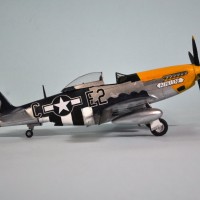





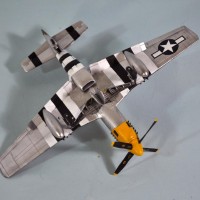
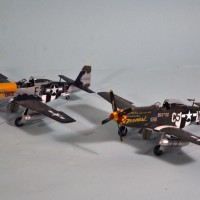
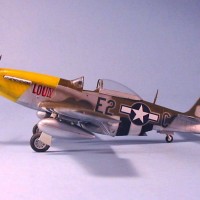

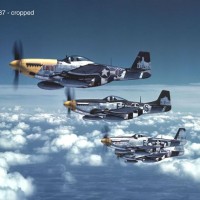





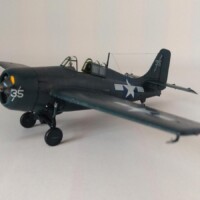
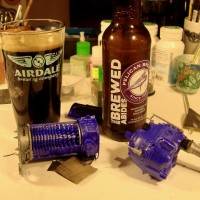
Great model; and as usual, your history "lesson" is interesting and full of good information.
Well done, Tom!
Paraphrasing Orwell: " all compliments are wonderful, but some are more wonderful than others."
Yours, Jeff, is firmly in Category 2.
thanks!
Well deserved, Sir!
Another great looking Mustang Tom. It looks really sharp in the blue scheme.
Coming from the guy I would nominate for "Best Model Painter", I really appreciate this.
Beautiful build of one of my favorite Mustangs. The blue does actually look right.
You're right. It really does.
Nice colourful build. Nothing like bit of colour controversy to stir the pot. After spending decades either out of sight of land or at remote mine sites I learnt to use whatever was at hand at the time if it was fit for purpose.
Thanks guys - all comments are great!
Good stuff Tom. And here I'd just bought into the "its all green" theory
Airfix obviously did too - I think looking at their color instructions that they found my first article.
most excellent build and article Tom.
Well done Tom @tcinla, both the builds and the write up. Covering a "Touchy" subject with great eloquence is a difficult task and you have done it in spades.
I too believe in the Al Superczynski philosophy, “Build what YOU want, the way YOU want to, and above all, have fun.”
A good read and a great looking P-51. Thanks Tom!
Great job as usual, Tom. Your build is beautiful. I REALLY loved the "how many rivet counters can dance on the head of a pin" discussion on the subject of blue v. green.
Like I said, "the reason academic wars are so bloody is because there's so little at stake." Same with models.
Nice job, Tom. Thanks for the tip about swapping out the stabilizers for the Eduard parts.
Really enjoy these extensive write-ups Tom. Sometimes the research is as much fun as the build. Great looking 'Stang.
I really appreciate hearing this. To me, the research IS the build,
The cops like to talk about the "Thin Blue Line" in protecting the populace. Now we have the "Thin Gray Line" of modeling. Or a little détente in moderating color call outs goes along ways in making the hobby interesting and fun.
Two thumbs up TC.
Nice Pony, and whatever the reality, it looks great with that interesting blue/green scheme! What's not to like about the non-normal?!